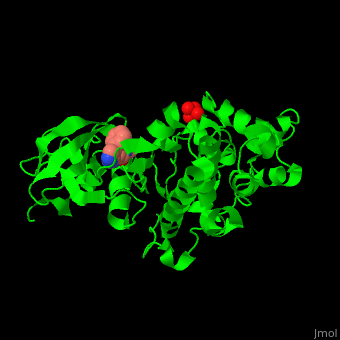Mitogen-activated protein kinase
From Proteopedia
FunctionMitogen-activated protein kinase (MAPK) also known as Extracellular Signal-Regulated Kinase (ERK) are serine/threonine kinases which regulate various cellular activities in response to extracellular stimuli by mitogens, heat shock and more. MAPK is part of the MAPK cascade which consists of MAPK, MAP2K and MAP3K which are activated by phosphorylation[1]. See also Mitogen-activated protein kinase cascade.
RelevanceMAPK cascade is elevated in cancer cells, hence MAPK inhibitors are tested as potential cancer therapy. DiseaseMAPK14 is associated with acquired hyperkeratosis and prostate transitional cell carcinoma. Structural highlightsInhibitors of MAPK bind in its ATP-binding site[2]. Water molecule are shown as red sphere. 3D Structures of Mitogen-activated protein kinaseMitogen-activated protein kinase 3D structures
|
| |||||||||||
References
- ↑ Robinson MJ, Cobb MH. Mitogen-activated protein kinase pathways. Curr Opin Cell Biol. 1997 Apr;9(2):180-6. PMID:9069255
- ↑ Aronov AM, Baker C, Bemis GW, Cao J, Chen G, Ford PJ, Germann UA, Green J, Hale MR, Jacobs M, Janetka JW, Maltais F, Martinez-Botella G, Namchuk MN, Straub J, Tang Q, Xie X. Flipped out: structure-guided design of selective pyrazolylpyrrole ERK inhibitors. J Med Chem. 2007 Mar 22;50(6):1280-7. Epub 2007 Feb 15. PMID:17300186 doi:http://dx.doi.org/10.1021/jm061381f

